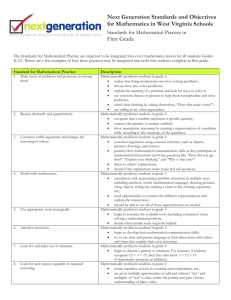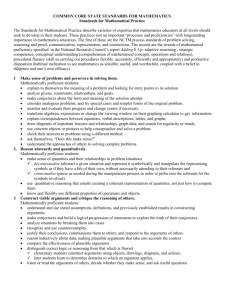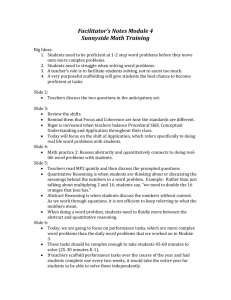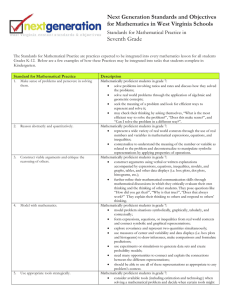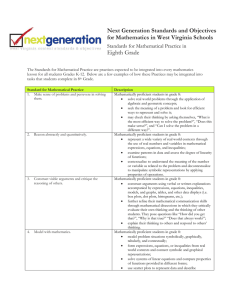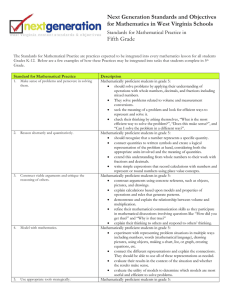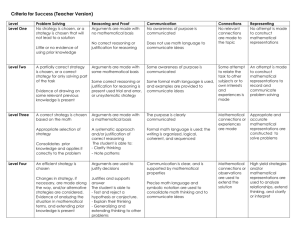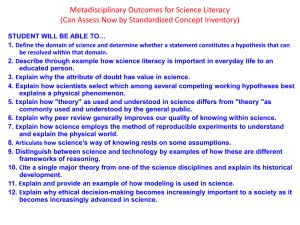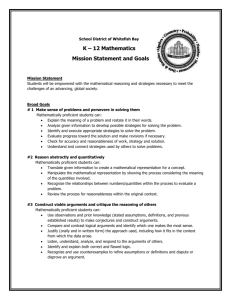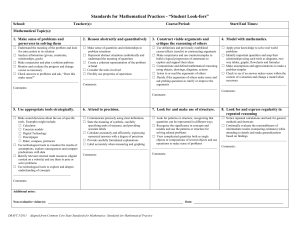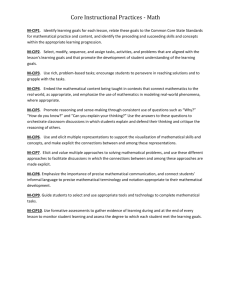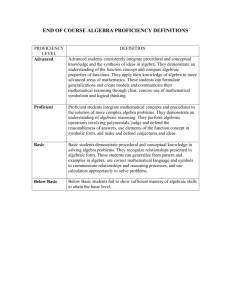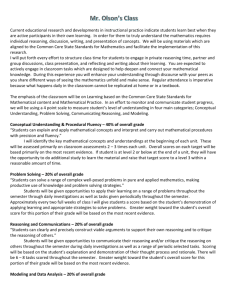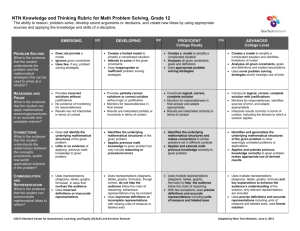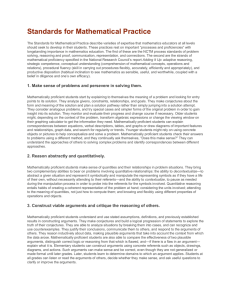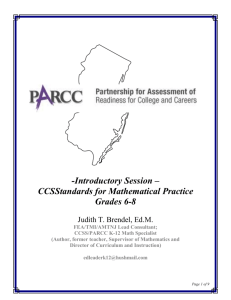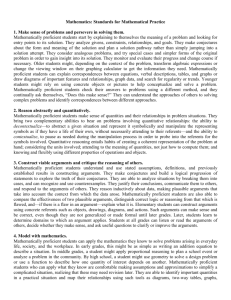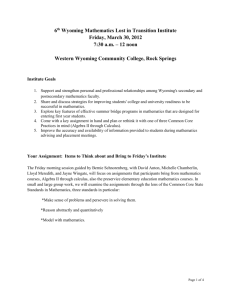File
advertisement
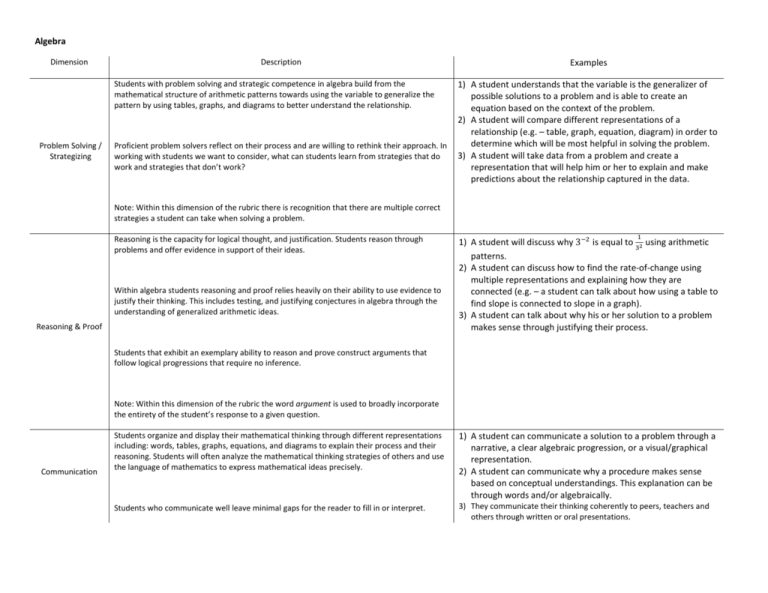
Algebra Dimension Description Students with problem solving and strategic competence in algebra build from the mathematical structure of arithmetic patterns towards using the variable to generalize the pattern by using tables, graphs, and diagrams to better understand the relationship. Problem Solving / Strategizing Proficient problem solvers reflect on their process and are willing to rethink their approach. In working with students we want to consider, what can students learn from strategies that do work and strategies that don’t work? Examples 1) A student understands that the variable is the generalizer of possible solutions to a problem and is able to create an equation based on the context of the problem. 2) A student will compare different representations of a relationship (e.g. – table, graph, equation, diagram) in order to determine which will be most helpful in solving the problem. 3) A student will take data from a problem and create a representation that will help him or her to explain and make predictions about the relationship captured in the data. Note: Within this dimension of the rubric there is recognition that there are multiple correct strategies a student can take when solving a problem. Reasoning is the capacity for logical thought, and justification. Students reason through problems and offer evidence in support of their ideas. Within algebra students reasoning and proof relies heavily on their ability to use evidence to justify their thinking. This includes testing, and justifying conjectures in algebra through the understanding of generalized arithmetic ideas. Reasoning & Proof 1 1) A student will discuss why 3−2 is equal to 2 using arithmetic 3 patterns. 2) A student can discuss how to find the rate-of-change using multiple representations and explaining how they are connected (e.g. – a student can talk about how using a table to find slope is connected to slope in a graph). 3) A student can talk about why his or her solution to a problem makes sense through justifying their process. Students that exhibit an exemplary ability to reason and prove construct arguments that follow logical progressions that require no inference. Note: Within this dimension of the rubric the word argument is used to broadly incorporate the entirety of the student’s response to a given question. Communication Students organize and display their mathematical thinking through different representations including: words, tables, graphs, equations, and diagrams to explain their process and their reasoning. Students will often analyze the mathematical thinking strategies of others and use the language of mathematics to express mathematical ideas precisely. 1) A student can communicate a solution to a problem through a narrative, a clear algebraic progression, or a visual/graphical representation. 2) A student can communicate why a procedure makes sense based on conceptual understandings. This explanation can be through words and/or algebraically. Students who communicate well leave minimal gaps for the reader to fill in or interpret. 3) They communicate their thinking coherently to peers, teachers and others through written or oral presentations. Mathematical Thinking Dimensions Common Core Mathematical Practice Standards Problem Solving / Strategizing MP1 – Mathematically proficient students start by explaining to themselves the meaning of a problem and looking for entry points to its solution. They analyze givens, constraints, relationships, and goals. They make conjectures about the form and meaning of the solution and plan a solution pathway rather than simply jumping into a solution attempt. They consider analogous problems, and try special cases and simpler forms of the original problem in order to gain insight into its solution. They monitor and evaluate their progress and change course if necessary. - Perseverance is hard to measure - CCS doesn’t talk about perseverance in the description of MP1 at all, but rather the qualities of a proficient problem solver. MP2 – the ability to decontextualize—to abstract a given situation and represent it symbolically and manipulate the representing symbols as if they have a life of their own, without necessarily attending to their referents—and the ability to contextualize, to pause as needed during the manipulation process in order to probe into the referents for the symbols involved….Quantitative reasoning entails habits of creating a coherent representation of the problem at hand; considering the units involved; attending to the meaning of quantities, not just how to compute them; and knowing and flexibly using different properties of operations and objects. MP6 – They calculate accurately and efficiently MP7 – Mathematically proficient students look closely to discern a pattern or structure. Reasoning and Proof - Reasoning is a larger notion than a viable argument. - In HS our central goal is to develop a broad notion of proof (see Prof. Wu) where argument is embedded within the idea of proof. - Critiquing the reasoning of others primarily takes place in the classroom and thus is not primarily something exhibited in a task. Communication - Communication is essential to all disciplines. Problem solving/strategizing, reasoning, representations, and mathematical connections are essential to mathematical communication. - We notice that the creators of the common core used the word communicate in different Practices and we felt it could be combined into one strand. MP3 – Mathematically proficient students understand and use stated assumptions, definitions, and previously established results in constructing arguments. They make conjectures and build a logical progression of statements to explore the truth of their conjectures. They justify their conclusion…They reason inductively about data, making plausible arguments that take into account the context from which the data arose. MP1 – Mathematically proficient students can explain correspondences between equations, verbal descriptions, tables, and graphs or draw diagrams of important features and relationships, graph data, and search for regularity or trends. MP3 – communicate them (the justification of their conclusions) to others MP6 – They try to use clear definitions in discussion with others and in their own reasoning. They state the meaning of the symbols they choose, including using the equal sign consistently and appropriately. They are careful about specifying units of measure, and labeling axes to clarify the correspondence with quantities in a problem.
